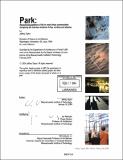Park : reassessing patterns of life in small urban communities : designing the interface between living, working and playing
Author(s)
Taylor, Jeffrey, 1972-
DownloadFull printable version (16.44Mb)
Alternative title
Reassessing patterns of life in small urban communities : designing the interface between living, working and playing
Other Contributors
Massachusetts Institute of Technology. Dept. of Architecture.
Advisor
Jan Wampler.
Terms of use
Metadata
Show full item recordAbstract
Today, many small urban communities look to their historic downtown districts as a great resource for regenerating economic vitality and creating cultural identity. However, one common problem experienced by many of these communities lies in the incompatibility between contemporary patterns of living and the existing built fabric of these downtowns. Sociocultural shifts in the American life-style as well as shifts in our transportation patterns have created a mismatch between places of work, places of residence and places of recreation, rendering these downtown areas ill-adapted to meet contemporary patterns of living. Although the building stock in these places may adequately meet the budding demand, the fundamental inadequacy in parking facilities creates a problem limiting the potential habitation of the district. The parking infrastructure and municipal parking policies become key elements in the eventual health of these communities. Because most people who live, work, or shop in these areas own an automobile, a bottleneck occurs for those attempting to utilize the area. Vital nodes of many downtown districts tend to cluster around existing parking garages, however, these parking facilities are expensive to build, and when constructed, are often physically removed from the center of activity rendering them underutilized or they inadvertently occupy precious real estate, obliterating the continuity of the street and pedestrian activity necessary for healthy businesses. Many communities attempt to solve their needs for parking in a nearsighted manner, looking only at parking in terms of supply and demand. However, ultimately, the downtown neighborhood needs to be viewed as a type of ecosystem consisting of interrelated parts that make up a whole. (cont.) Equal consideration should be given to all these parts of this urban ecology if is to develop in a sustainable fashion. Pittsfield, Massachusetts typifies this kind of community. I use the setting of Pittsfield to first address the problem at an urban design level, identifying areas for parking and mixed-use development which can be utilized to bolster investment in underdeveloped areas of downtown, to steer growth in a way which connects urban nodes, and to extend the benefits of this growth into the neighboring areas. Second, to address the issue on an architectural level, I explore the design of a prototypical parking structure, demonstrating how careful consideration of pedestrian activity to and from one's automobile can play a part in the design of the parking as well as adjacent buildings, and in turn, how these various buildings activate a healthy urban life-style. The parking garage becomes a vital piece of the city, which begins to provide a framework in and around which the Urban Ecosystem can begin to flourish. The result is a typological shift in the fabric of the downtown, one which improves the area's capacity to host the myriad of activities found in healthy urban communities. The thesis demonstrates how the design of typically mundane buildings such as parking facilities can be approached more comprehensively to facilitate and moderate the interaction between people, automobiles, and the environment.
Description
Thesis (M. Arch.)--Massachusetts Institute of Technology, Dept. of Architecture, 2004. Includes bibliographical references (p. 68-70).
Date issued
2004Department
Massachusetts Institute of Technology. Department of ArchitecturePublisher
Massachusetts Institute of Technology
Keywords
Architecture.